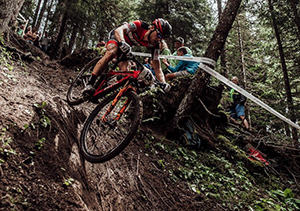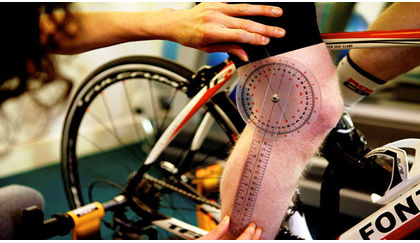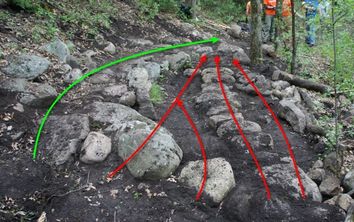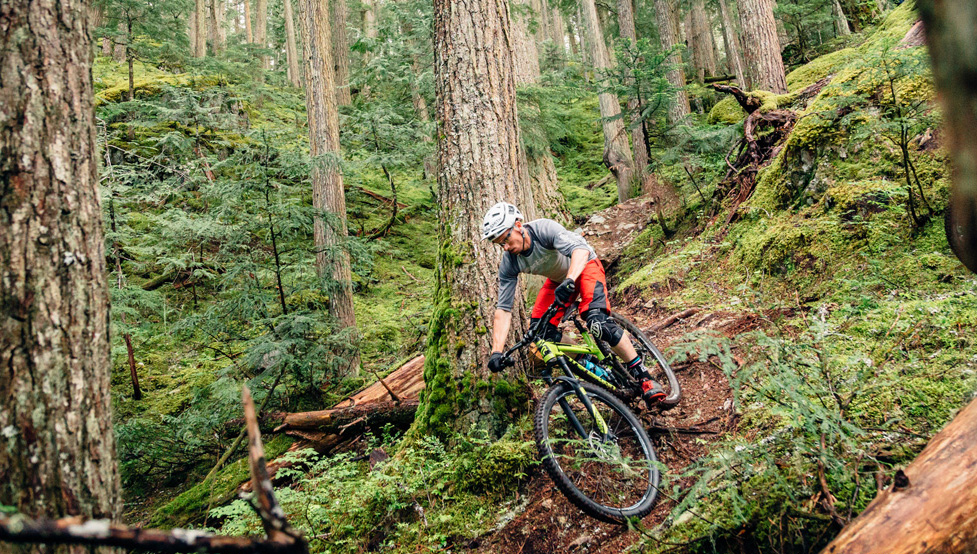There’s one thing that can scare almost any MTB rider regardless of how experienced they are — riding slippery, wet, off-camber roots. No matter if the trail is flat or steep, slippery roots can turn even the most mellow section of a trail into an unpredictable nightmare. This often leads to injuries for those who don't know how to properly navigate them.
Like any skill, you can first learn to understand, then progress towards conquering those slippery roots. Here’s how:
Line choice
Trail riding is a game of momentum, where the fastest riders are those who can keep their momentum going throughout the ups and downs experienced on a trail. One key factor to maintain momentum is your line choice. When you approach a section that you think may be slippery take note of the direction the roots are going and which ways the ground undulates. You want to be thinking of finding the best track for your tires to follow. Ideally, you want to take the path that's smoothest and as direct as possible, allowing you to better predict the grip you'll have with your tires.
RELATED: Hottest new MTB tires
Look for either the most flat-ish or the most straight down route with as few roots as possible. You’re better to ride on the high side of a trail where there is just one thick root before it branches out into multiple, smaller roots.
You also want to make sure that there aren’t other obstacles mixed in with the slippery roots, such as rocks, mud, wet leaves, etc. If you see a spot where there are no roots, it may be because there’s a rock there instead — keep that in mind. The trail comes at you quick, so you have to learn to use peripheral vision and to make quick decisions to keep your momentum up.
Let it float

photo: RedBull.com
Believe it or not, your body is a better shock absorber than any suspension product available on the market. Your knees and elbows can free float with endless travel and feature split second reaction times, allowing precise on-the-fly adjustments to the trail in front of you. To make the most out of your natural abilities, you must learn how, and when, to let your bike float underneath you.
This is accomplished by a combination of confidence and physical coordination. You need to relax, pick your line, keep your muscles engaged and your joints soft but ready to react. You want to approach the slippery roots with some speed (momentum) and you want to be able to un-weight your bike by almost preloading before you hit the first root, then keep a firm grip on your bars and let your bike bounce and rattle beneath you. Keep your eyes firmly on your end point and don’t let up until you’re there. Try not to use your brakes.
Lay off the brakes
This is a crucial skill to learn as the most common reason why you lose traction over roots is applying the brakes. Roots are like corners; proper momentum management means you brake before, not during, the obstacle. When you corner, you want to be going the right speed for the corner before you enter it; you don’t want to be braking during the corner as this is much slower. Riding slippery roots is mostly the same — you want to brake before the roots and allow your wheels to rotate freely over top of them.
When you apply your brakes, you tend to lose traction. Slowing the rotation of your wheels means your momentum will no longer allow you to roll along over the slippery roots and you end up sliding down them, instead. This technique is absolutely key when riding down steep trails in the wet as we tend to ride the brakes the entire way down. When you brake over wet roots your tire will follow the root and not the trail. This can cause your front or rear tire to rapidly slide off the trail and can be exceptionally dangerous, especially when it’s your front tire.
Riding steep trails means your butt should be back off your seat and as close to your rear axle as possible. (Consider a dropper post if you don't already have one.) Under normal circumstances, you feather the brakes to maintain a balance between forward momentum and control. Nothing makes you freeze up more than a set of wet off-camber roots in the middle of a butt dragging steep, so pick your line, brake before the roots, and let your bike roll freely.
Don’t pedal

photo: RedBull.com
Pedaling over roots can disrupt the momentum that you need to guide you over obstacles smoothly. When you pedal, you tend to lean your bike side–to-side ever so slightly, which can be enough to make your tires break loose over the roots. The torque you apply to your wheels is also enough to cause you to spin out over the roots, which breaks your momentum and can send your knees hurtling into your bars.
Much like braking, you want to properly manage your speed coming into the root section by pedaling as much as needed. This is often the case when you need to navigate roots on a punchy uphill climb. Use your vision to pick a line as early as possible, then get on the gas! Pedal hard until you feel confident you are going the right speed to make it over the roots with as little disruption to your momentum as possible.
If you absolutely have to pedal, like when there are roots on a flat section of trail, you have to combine a few techniques to ensure you maintain grip and momentum. You want to shift into a harder gear so your cranks are rotating at a slower pace and where you can use more brute strength with your legs. You want to pedal slowly and unweight your bike as it passes over the roots. Make sure to be standing up out of the saddle to allow your bike more room to move underneath you and to take the weight off your tires. Use a combination of power pedaling and unweighting your bike to pass smoothly over the roots.
Things don’t change uphill
Uphill roots can be deceivingly difficult as they can yield the same results as downhill roots, so don’t lose focus or intensity when approaching an uphill root section. You want to remember that without pedaling, you lose momentum rapidly uphill so you want to approach the hill at the speed you need to clear the root section, which might mean you have to be heavy on the gas coming into the hill. If the roots are at the top of the punchy climb then you want to stay focused and pedal hard up the hill, but if you are forced to ride them at a slow pace you have to be ready to change your game plan.
RELATED: Don't give up on your mountain bike!
If you lost all your momentum and find yourself having to slowly slog through the slippery roots, then you have to ride the fine line between input and balance. When you have to add momentum through pedaling, you want to pick your exact moment to sneak in a pedal stroke or two, or sometimes just a half. It may be a tall order, but you may have to pick two lines coming into the roots, one for momentum and one for pedaling, and they can be quite different. Look for gaps between the roots for you to be able to apply pressure to your pedals and give yourself a boost; combine this with unweighting your bike and you should be able to navigate the roots without issue.
Commit

photo: RedBull.com
The most important thing to do once you’ve chosen your line is to fully commit to it. If you aren’t committed, you will find yourself making numerous mistakes that will almost certainly lead to a crash. When you don’t commit, you switch your line at the last moment to what is usually a less safe line, resulting in hitting obstacles you never saw on approach. You also tend to drag your brakes, or lock them up completely, which is the quickest way to slide out and crash. You will also misjudge the speed you need to clear the roots, making you pedal like a madman over them, which feels like trying to run across a hardwood floor in wool socks.
Try to remember that teams of people have spent millions of dollars engineering and testing the products you are riding. Without trust, you don’t give your tires a chance to hook up properly, or you don’t allow the suspension on your bike to do a masterful job of supporting you while keeping your wheels connected to the ground. Keep these tips in mind the next time you head out on the trails. Practice these techniques when the trails are dry so you can get the fundamentals down before things get wet and slippery.

RELATED ARTICLE:
Bike Fit: Does size matter?
If you're in the market for a new bike you should make fit your number one priority.BikeRoar brings you industry advice on why bike fit matters and why... READ MORE

RELATED ARTICLE:
Mountain bike skills: Choosing a line, handling gravel and drop-offs
Mountain biking can be quite challenging as you never know what obstacles may be around the next corner.BikeRoar is here to give you some tips on how you can master all the skiils you will need... READ MORE



